 Here's to us waking up bewildered and trying to piece together tonight from fragmentary memories and vague sensations of shame. 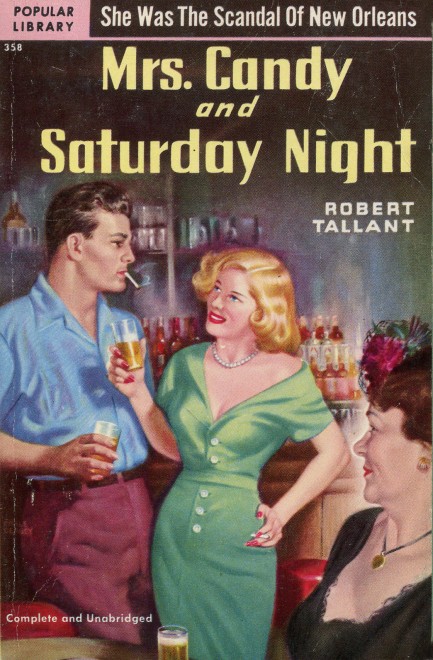
Above, a cover for Robert Tallant's Mrs. Candy and Saturday Night. Basically, a woman who runs a New Orleans boarding house filled with unusual renters and a ghost decides to throw a party, which turns out wilder than she expected and leads to some startling revelations about the occupants. Written to span twenty-four hours, the book was well received enough to spawn two sequels, Love and Mrs. Candy and Mrs. Candy Strikes It Rich. The success was not a surprise. Tallant was born in New Orleans, was already experienced writing about it through other published books, and obviously loved the place, quirks and all. If you're looking for real Crescent City feel in a mid-century novel, with jambalaya, voodoo, and all the rest, Mrs. Candy and Saturday Night is it. It's originally copyright 1947, with this Popular Library paperback with Earle Bergey cover art coming in 1951.
 Do you mean it'll feel like forever? Or do you mean it's a permanent commitment? Because we should talk about that. 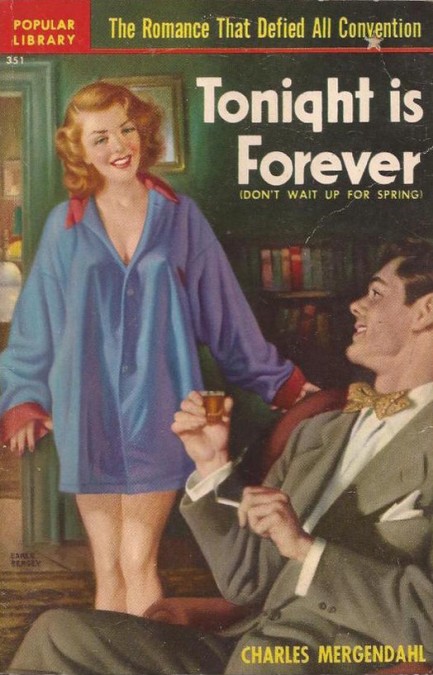
Originally called Don't Wait Up for Spring and published in 1944, Charles Mergendahl's Tonight Is Forever was published in paperback by Popular Library in 1951 with the great Earle Bergey art you see here. The story concerns a playwright and the lead actress of his play, her convention defying decision to pursue him and do whatever it takes to generate a marriage proposal, even though he's headed off to the army in three weeks. What is a little thing like virginity, after all, when half the planet is at war?
 She’s got a dilly of a pickle on her hands. 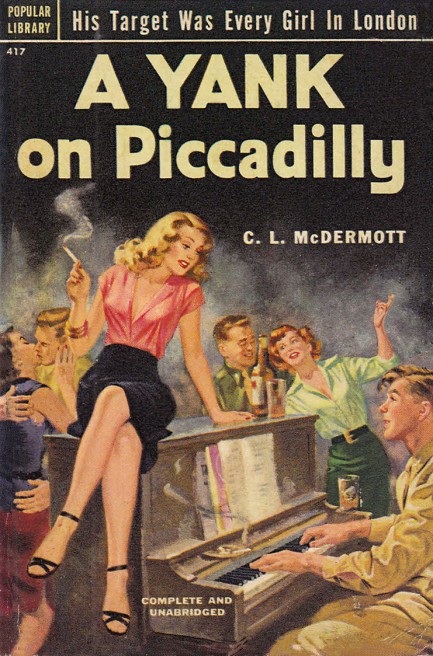
A Yank on Piccadilly is another book that sounds blatantly pornographic, at least to us, but it's merely the adventures of an American soldier in World War II London. Mild sexual involvement? Yes, there's some of that. Dick yanking? Lamentably, no. In case you’re curious, the name Piccadilly comes from “piccadill,” which was a stiff—cough cough—collar with scalloped edges and a lace border that was the fashion rage during the late sixteenth century. The websites we checked have this cover as by an unidentified artist, but it’s Earle Bergey’s work, clearly. 1952 publication date.
 Sweetie, stop. I said I like sensitive men, but I meant one who puts the toilet seat down. 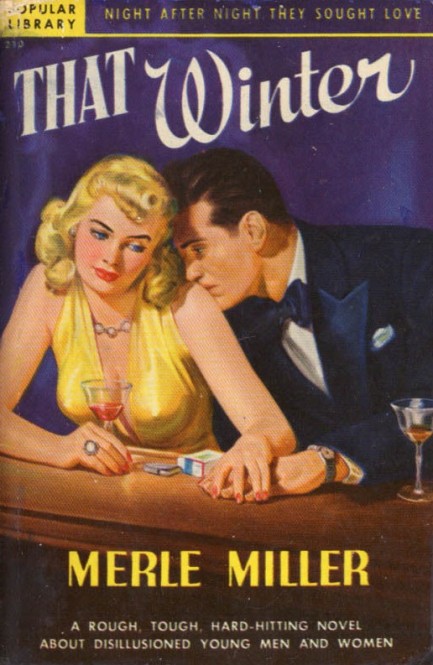
Merle Miller’s That Winter is one of the better post-World War II novels, dealing with the time-honored theme of veterans struggling to fit in after their military service. One has a dead end job, another believes he can function only in the army, and another is trying to hide the fact that he’s Jewish. In the area of feeling forced to hide an essential aspect of oneself, Miller knew exactly what he was writing about. In 1971 at the age of fifty-one, during a time when he was a public intellectual of considerable stature, he came out in the New York Times Magazine as gay. The article catapulted him into the forefront of gay activism, a status he maintained the rest of his life. That Winter was his first novel, appearing in 1948, with the above Popular Library edition hitting shelves in 1950. The great cover art could be by Earle Bergey, but Christopher P. Stephens’ reference tome A Checklist of the Popular Library Paperbacks lists no illustrator, so we’ll have to go with unknown on this one for now.
 Maybe they're angry they weren't invited to the slumber party. 
This chaotic scene of terrified earthlings in their pajamas being swarmed by UFOs is one of the cooler vintage book covers you’ll see. Behind the Flying Saucers was Frank Scully's discussion of the origin of extraterrestrials, with a finger pointed squarely at the U.S. government for covering up evidence of their existence. He first aired his views in 1949 in his column in the publication Variety, and the next year expanded upon them in book form. The art, which was painted by Earle Bergey, is from the 1951 paperback edition. Behind the Flying Saucers was one of the first UFO books and its influence has been enduring. Scully inspired the name of Gillian Anderson’s immortal character on The X-Files, and we’ve seen this paperback online going for as much as $150. Thanks to the wonders of modern technology you don’t have to pay that much, or anything, for that matter, because you can read the entire text online here, or download it just about anywhere. As to whether any of what Scully wrote was true, like we’ve said before, if aliens could fly here from millions of light years away we’re pretty sure they’d have mastered the ability to go unobserved. We also think that an advanced race—after seeing how we kill each other by the millions, destroy our habitat, tolerate mass starvation, and are locked in a bizarre system of debt peonage designed to enrich an entrenched few—would not only do a screeching U-turn back to the far reaches of the cosmos, but would put up a giant intergalactic advisory sign telling travelers to steer clear of Earth at all costs. But we digress. Since the universe is too vast not to contain extraterrestrial life of some sort, maybe visitors have been here. You never know.
 Their eyes were watching bod. 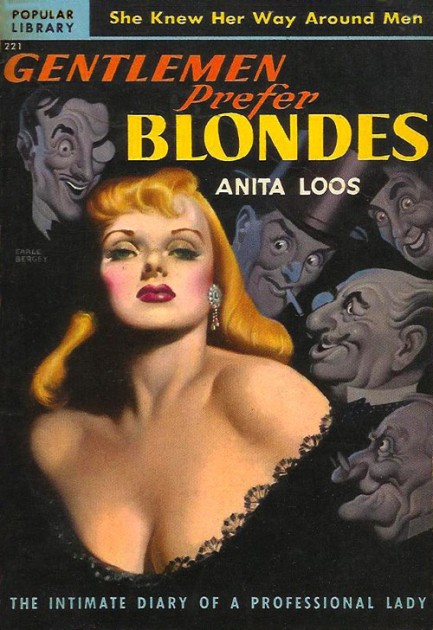
We love this cover for Anita Loos’ 1925 novel of ambition and materialism Gentlemen Prefer Blondes. Brilliantly rendered by Earle Bergey, the so-called gentlemen here are leering caricatures evincing monstrous thirst for the beautiful young blonde. The book became a bestseller and, twenty-three years later, a film with Marilyn Monroe and Jane Russell which premiered today in 1958. The book’s cover image helped establish Bergey’s reputation as an illustrator without peer, and more than eighty years later it’s one of the most common pulp images on the internet. We’ll post more Bergey art later, and also revisit Anita Loos.
|
 |

The headlines that mattered yesteryear.
2003—Hope Dies
Film legend Bob Hope dies of pneumonia two months after celebrating his 100th birthday. 1945—Churchill Given the Sack
In spite of admiring Winston Churchill as a great wartime leader, Britons elect
Clement Attlee the nation's new prime minister in a sweeping victory for the Labour Party over the Conservatives. 1952—Evita Peron Dies
Eva Duarte de Peron, aka Evita, wife of the president of the Argentine Republic, dies from cancer at age 33. Evita had brought the working classes into a position of political power never witnessed before, but was hated by the nation's powerful military class. She is lain to rest in Milan, Italy in a secret grave under a nun's name, but is eventually returned to Argentina for reburial beside her husband in 1974. 1943—Mussolini Calls It Quits
Italian dictator Benito Mussolini steps down as head of the armed forces and the government. It soon becomes clear that Il Duce did not relinquish power voluntarily, but was forced to resign after former Fascist colleagues turned against him. He is later installed by Germany as leader of the Italian Social Republic in the north of the country, but is killed by partisans in 1945.
|

|
|

It's easy. We have an uploader that makes it a snap. Use it to submit your art, text, header, and subhead. Your post can be funny, serious, or anything in between, as long as it's vintage pulp. You'll get a byline and experience the fleeting pride of free authorship. We'll edit your post for typos, but the rest is up to you. Click here to give us your best shot.

|
|
















































































